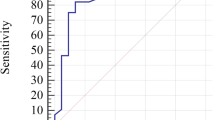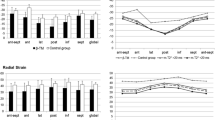Abstract
Thalassemia defined a spectrum of diseases characterized by reduced or absent production of one of the globin chains of hemoglobin. High iron deposition in the myocardium may cause functional impairment even before any changes in left ventricular (LV) ejection fraction. These impairments may appear as changes in strain values. Early detection of myocardial dysfunction is essential for improving survival and preventing further complications. Therefore, this study aims to evaluate the cardiac strain patterns by Feature Tracking -Cardiac Magnetic Resonance Imaging (FT-CMR) method and their correlation with T2* values as a new parameter in determining myocardial iron overload (MIO). In this retrospective investigation, ninety-one patients with B-thalassemia major included from May 2016 to July 2019. Twenty-three healthy subjects, also incorporated as a control group. CMR used to evaluate ventricular volumes, LVEF, and the amount of myocardial T2*. Moreover, Global Longitudinal Strain (GLS), Global Circumferential Strain (GCS), and Global Radial Strain (GRS) were measured and analyzed in both rights and left ventricles. Correlations of cardiac T2* with GLS, GCS, and GRS were evaluated. The optimal cutoff value of GLS for prediction of cardiac T2* < 20 ms (as an indicator of inadequate chelation) calculated as well. There were significant correlations between cardiac T2* with LV GLS, LV GCS, and right ventricular GLS (p < 0.05 for each one). Moreover, a significant difference detected between the group of TM − MIO and TM + MIO and control group in terms of GLS (p < 0.001). The optimal cutoff value of GLS for prediction of cardiac T2* < 20 ms was at − 16.5% with sensitivity and specificity of 73% and 63%, respectively. Our study demonstrates that strain values measured by FT and myocardial T2* values are correlated. FT-CMR can be considered as an efficient tool for early detection of iron deposition and its effects on cardiac tissue so that proper and timely modification could have applied to chelation therapy.



Similar content being viewed by others
Data availability
The data supporting the findings of the article is available in the research deputy of Iran University of Medical Sciences.
References
Poorzand H, Manzari TS, Vakilian F, Layegh P, Badiee Z, Norouzi F, Morovatdar N, Sani ZA (2017) Longitudinal strain in beta thalassemia major and its relation to the extent of myocardial iron overload in cardiovascular magnetic resonance. Arch Cardiovasc Imaging 5:1–5
Parsaee M, Akiash N, Azarkeivan A, Alizadeh Sani Z, Amin A, Pazoki M, Samiei N, Jalili MA, Adel MH, Rezaian N (2018) The correlation between cardiac magnetic resonance T2* and left ventricular global longitudinal strain in people with β-thalassemia. Echocardiography 35(4):438–444
Cusmà Piccione M, Piraino B, Zito C et al (2013) Early identification of cardiovascular involvement in patients with b-thalassemia major. Am J Cardiol 112:1246–1251
Ari ME, Ekici F, Çetin İİ et al (2017) Assessment of left ventricular functions and myocardial iron load with tissue Doppler and speckle tracking echocardiography and T2* MRI in patients with beta thalassemia major. Echocardiography 34:383–389
Cheung YF, Liang XC, Chan GC et al (2010) Myocardial deformation in patients with Beta-thalassemia major: a speckle tracking echocardiographic study. Echocardiography 27:253–259
Hamdy AM (2007) Use of strain and tissue velocity imaging for early detect ion of regional myocardial dysfunction in patients with beta thalassemia. Eur J Echocardiogr 8:102–109
Fernandes JL (2012) Iron chelation therapy in the management of transfusion-related cardiac iron overload. Transfusion 52(10):2256–2268
Karamanou AG, Hamodraka ES, Vrakas SC et al (2014) Assessment of left ventricular and atrial diastolic function using two-dimensional(2D) strain imaging in patients with β-thalassemia major. Eur J Haematol 92:59–65
Carpenter JP, He T, Kirk P et al (2011) On T2* magnetic resonance and cardiac iron. Circulation 123:1519–1528
Aypar E, Alehan D, Hazirolan T et al (2010) The efficacy of tissue Doppler imaging in predicting myocardial iron load in patients with beta thalassemia major:correlation with T2* cardiovascular magnetic resonance. Int J Cardiovasc Imaging 26:413–421
Monte I, Buccheri S, Bottari V et al (2012) Left ventricular rotational dynamics in beta thalassemia major: a speckle-tracking echocardiographic study. J Am Soc Echocardiogr 25:1083–1090
Vogel M, Anderson LJ, Holden S et al (2003) Tissue Doppler echocardiography in patients with thalassaemia detects early myocardial iron dysfunction related to myocardial iron overload. Eur Heart J 24:113–119
Ramazzotti A, Pepe A, Positano V et al (2009) Multicenter validation of the magnetic resonance T2* technique for segmental and global quantification of myocardial iron. J Magn Reson Imaging 30:62–68
Westwood MA, Anderson LJ, Firmin DN et al (2003) Interscanner reproducibility of cardiovascular magnetic resonance T2* measurements of tissue iron in thalassemia. J Cardiovasc Magn Reson 18:616–620
Seldrum S, Pierard S, Moniotte S et al (2011) Iron overload in polytransfused patients without heart failure is associated with subclinical alterations of systolic left ventricular function using cardiovascular magnetic resonance tagging. J Cardiovas Magn Reson 13:23
Modell B, Khan M, Darlison M, Westwood MA, Ingram D, Pennell DJ (2008) Improved survival of thalassaemia major in the UK and relation to T2* cardiovascular magnetic resonance. J Cardiovasc Magn Reson 10(1):42
Habibzadeh F, Yadollahie M, Merat A, Haghshenas M (1998) Thalassemia in Iran; an overview. Arch Irn Med 1:27–33
Chu WC, Au WY, Lam WW (2012) MRI of cardiac iron overload. J Magn Reson Imaging 36(5):1052–1059
Taher A, Hershko C, Cappellini MD (2009) Iron overload in thalassaemia intermedia: reassessment of iron chelation strategies. Br J Haematol 147(5):634–640
Baraldi-Junkins C, Levin HR, Kasper EK, Rayburn BK, Herskowitz A, Baughman KL (1993) Complications of endomyocardial biopsy in heart transplant patients. J Heart Lung Transplant 12(Pt 1):63–67
Liu P, Henkelman M, Joshi J (1992) Quantification of myocardial tissue iron contents using NMR relaxation. Validation in a novel murine thalassemia model. JACC 19:187A
Chitiboi T, Axel L (2017) Magnetic resonance imaging of myocardial strain: a review of current approaches. J Magn Reson Imaging 46(5):1263–1280
Pedrizzetti G, Claus P, Kilner PJ, Nagel E (2016) Principles of cardiovascular magnetic resonance feature tracking and echocardiographic speckle tracking for informed clinical use. J Cardiovasc Magn Reson 18(1):51
Bunn HF, Forget BG (1986) Hemoglobin: molecular Genetic and Clinical aspects. WB Saunders, Philadelphia
Rund D, Rachmilewitz E (2005) Beta-thalassemia. N Engl J Med 353:1135
Pennell DJ, Udelson JE, Arai AE et al (2013) Cardiovascular function and treatment in β-thalassemia major: a consensus statement from the American Heart Association. Circulation 128:281
Weatherall DJ (1994) The thalessemias. In: Stamatoyannopoulos G, Nienhuis AW, Majerus PW (eds) Molecular basis of blood diseases, 2nd edn. WB Saunders, Philadelphia, p 157
Adams JG 3rd, Coleman MB (1990) Structural hemoglobin variants that produce the phenotype of thalassemia. Semin Hematol 27:229
Forget BG, Pearson HA (2000) Hemoglobin synthesis and the thalassemias. In: Hoffman R, Benz EJ Jr, Shattil SJ, et al. (eds) Hematology: basic principles and practice, 3rd edn. Churchill Livingstone, New York
Kwiatkowski JL, Kim HY, Thompson AA et al (2012) Chelation use and iron burden in North American and British thalassemia patients: a report from the Thalassemia Longitudinal Cohort. Blood 119:2746
Ambati SR, Randolph RE, Mennitt K et al (2013) Longitudinal monitoring of cardiac siderosis using cardiovascular magnetic resonance T2* in patients with thalassemia major on various chelation regimens: a 6-year study. Am J Hematol 88:652
Borgna-Pignatti C, Meloni A, Guerrini G et al (2014) Myocardial iron overload in thalassaemia major. How early to check? Br J Haematol 164:579
Origa R, Danjou F, Cossa S et al (2013) Impact of heart magnetic resonance imaging on chelation choices, compliance with treatment and risk of heart disease in patients with thalassaemia major. Br J Haematol 163:400
Rachmilewitz EA, Giardina PJ (2011) How I treat thalassemia. Blood 118:3479
Magrì D, Sciomer S, Fedele F et al (2008) Early impairment of myocardial function in young patients with beta-thalassemia major. Eur J Haematol. 80:515–522
Giusca S, Korosoglou G, Zieschang V et al (2018) Reproducibility study on myocardial strain assessment using fast-SENC cardiac magnetic resonance imaging. Sci Rep 8(1):14100
Claus P, Omar AMS, Pedrizzetti G, Sengupta PP, Nagel E (2015) Tissue tracking technology for assessing cardiac mechanics: principles, normal values, and clinical applications. JACC Cardiovasc Imaging 8(12):1444–1460
Pizzino F, Meloni A, Terrizzi A, Casini T, Spasiano A, Cosmi C, Allò M, Zito C, Carerj S, Aquaro GD, Di Bella G, Pepe A (2018) Detection of myocardial iron overload by two-dimensional speckle tracking in patients with beta-thalassaemia major: a combined echocardiographic and T2* segmental CMR study. Int J Cardiovasc Imaging 34(2):263–271
Garceau P, Nguyen ET, Carasso S, Ross H, Pendergrast J, Moravsky G, Bruchal-Garbicz B, Rakowski H (2011) Quantification of myocardial iron deposition by two-dimensional speckle tracking in patients with β-thalassaemia major and Blackfan-Diamond anaemia. Heart 97(5):388–393
Muser D, Castro SA, Santangeli P, Nucifora G (2018) Clinical applications of feature-tracking cardiac magnetic resonance imaging. World J Cardiol 10(11):210–221
Acknowledgements
We would like to thank Iran University of Medical Sciences for founding this study. We also thank the staff of Shahid Rajaee Teaching Hospital and members of Radiology Research Center of Iran University of Medical Sciences for their great support in study development.
Funding
None.
Author information
Authors and Affiliations
Corresponding author
Ethics declarations
Conflict of interest
The study authors declare no conflict of interest in terms of scientific collaboration and financial benefits.
Ethical approval
The study protocol was approved by the ethical committee of Shahid Rajaee hospital.
Informed consent
Written informed consent was acquired from all patients before including them in the study.
Research involving human participants and/or animal
No Animal subjects were used in the study. All research procedures were tracked by ethical standards of the responsible committee at Iran University of Medical Sciences.
Additional information
Publisher's Note
Springer Nature remains neutral with regard to jurisdictional claims in published maps and institutional affiliations.
Rights and permissions
About this article
Cite this article
Rezaeian, N., Mohtasham, M.A., Khaleel, A.J. et al. Comparison of global strain values of myocardium in beta-thalassemia major patients with iron load using specific feature tracking in cardiac magnetic resonance imaging. Int J Cardiovasc Imaging 36, 1343–1349 (2020). https://doi.org/10.1007/s10554-020-01835-3
Received:
Accepted:
Published:
Issue Date:
DOI: https://doi.org/10.1007/s10554-020-01835-3




